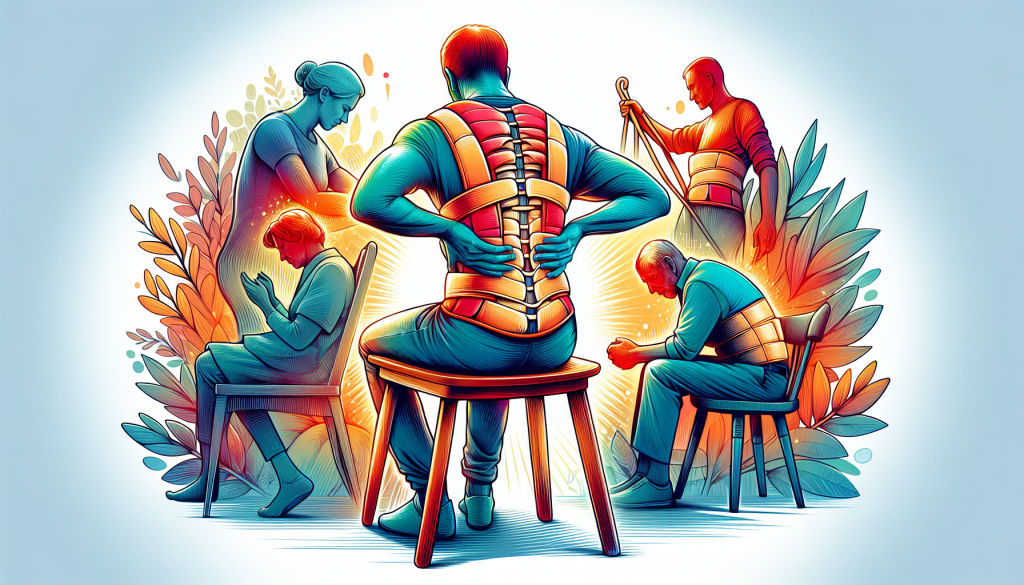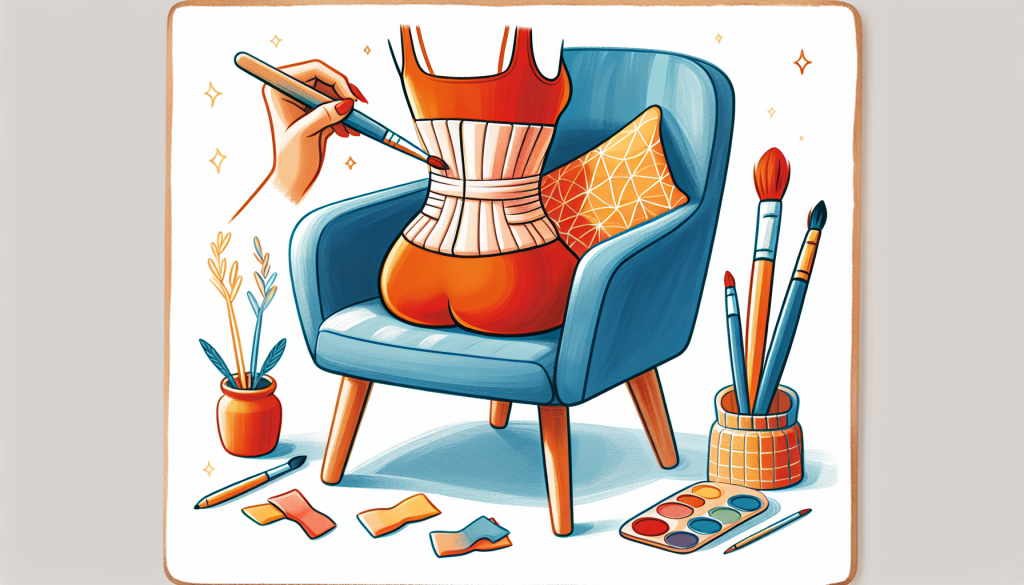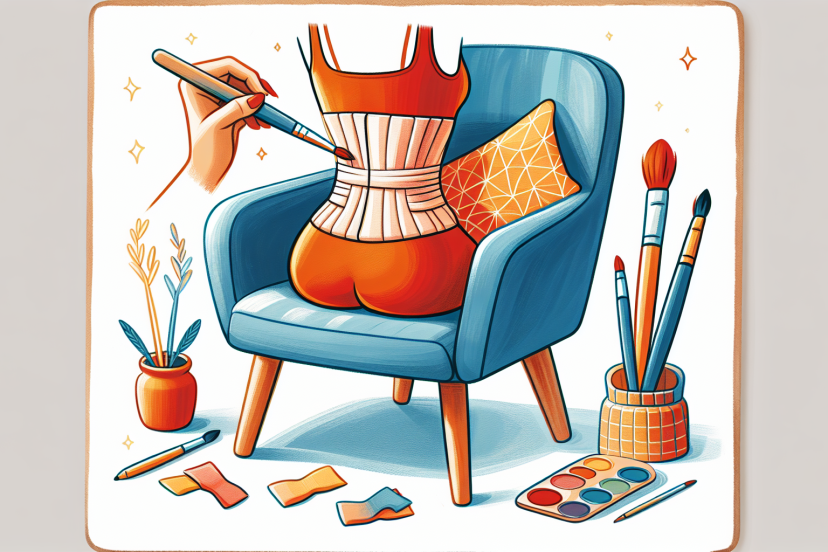DIY Back Support Strategies: From Heat Therapy To Posture Correcting
If you’ve been struggling with back pain and looking for ways to alleviate your discomfort, this article is for you. In this guide, we will explore a range of do-it-yourself (DIY) strategies to help support your back, from the soothing benefits of heat therapy to techniques for correcting your posture. Whether you’re dealing with chronic pain or simply want to maintain a healthy back, you’ll discover practical and accessible solutions to help you find relief and improve your overall well-being. Say goodbye to back pain and hello to a more comfortable and supported back with these DIY strategies.

Overview
Understanding the importance of back support
Taking care of your back is crucial for maintaining a healthy and pain-free lifestyle. Whether you are experiencing occasional discomfort or chronic back pain, there are various strategies you can implement to provide the support your back needs. In this article, we will explore a range of do-it-yourself (DIY) back support strategies that can help alleviate pain, strengthen your back, and promote overall well-being.
Heat Therapy
Applying heat to alleviate back pain
One effective method for relieving back pain is heat therapy. Applying heat to the affected area can increase blood flow, relax muscles, and ease discomfort. There are several ways to incorporate heat therapy into your routine. One common method is using a heating pad, which can be placed directly on the painful area for targeted relief. Another option is a hot water bottle, which provides a comforting and soothing sensation. You can also take warm showers or baths to relax your muscles and alleviate pain.
Different methods of heat therapy
Aside from heating pads and hot water bottles, there are other methods of heat therapy that can be beneficial for your back. Heat wraps, which can be easily applied and worn throughout the day, provide a constant source of heat. Some people find relief from using heat patches, which are applied to the skin and provide long-lasting heat. Additionally, heating creams or ointments can be gently massaged into the affected area for a warming sensation.
Cold Therapy
Using cold therapy for back pain relief
While heat therapy is effective for many individuals, cold therapy can also provide significant relief for back pain. Cold therapy works by reducing inflammation and numbing the affected area, helping to alleviate pain and swelling. An ice pack or a cold compress can be applied to the painful area for short periods of time, providing instant relief. It is important to wrap the ice pack in a thin cloth or towel to protect the skin from direct contact with the cold.
Types of cold therapy options
Apart from using ice packs or cold compresses, there are other options for incorporating cold therapy into your routine. Gel packs can be frozen and then applied to the back, providing a flexible and comfortable cold therapy experience. Cold sprays are another popular method, which can be sprayed onto the skin to create a cooling sensation. Cold therapy patches, similar to heat patches, can be applied and worn throughout the day for continuous relief.
Physical Exercises
Exercise routines to strengthen and support the back
Strengthening your back muscles through regular exercise can significantly improve your overall back health. Engaging in exercises that target the muscles surrounding the spine can help alleviate pain, improve posture, and prevent further injury. Some effective exercises for back support include:
- Partial curl-ups: Lie on your back with your knees bent and feet flat on the ground. Place your hands behind your head and slowly lift your head and shoulders off the ground, engaging your abdominal muscles. Hold for a few seconds, then lower yourself back down. Repeat this exercise for a few sets, gradually increasing the repetitions.
- Bridges: Lie on your back with your knees bent and feet flat on the ground. Slowly lift your hips off the ground, keeping your back straight. Hold for a few seconds, then lower yourself back down. Repeat this exercise for a few sets, gradually increasing the duration of the hold.
- Supermans: Lie on your stomach with your arms extended in front of you. Simultaneously lift your arms, chest, and legs off the ground, engaging your back muscles. Hold for a few seconds, then lower yourself back down. Repeat this exercise for a few sets, gradually increasing the repetitions.
Specific exercises for different types of back pain
Depending on the type and location of your back pain, certain exercises may be more beneficial for you.
- If you experience lower back pain, exercises such as Pelvic tilts, cat-camel stretches, and knee-to-chest stretches can help alleviate discomfort. These exercises target the lower back and can provide relief by stretching and strengthening the muscles in that area.
- For upper back pain, exercises such as shoulder blade squeezes, chest stretches, and thoracic rotations can be helpful. These exercises focus on improving posture and strengthening the muscles in the upper back, which can alleviate pain caused by poor posture or muscle imbalances.
Remember to start slowly and gradually increase the intensity and duration of your exercises to avoid overexertion. It is always a good idea to consult with a healthcare professional or a qualified trainer before starting any exercise regimen, especially if you have pre-existing back conditions.

Posture Correcting
Understanding the impact of poor posture on back health
Poor posture not only affects the way you look, but it can also have a severe impact on the health of your back. Slouching, hunching, or sitting for long periods with improper alignment can strain the muscles and ligaments in your back, leading to pain and discomfort. Maintaining proper posture is essential for keeping your spine in alignment and preventing unnecessary stress on your back.
Tips and techniques for maintaining proper posture
Improving your posture starts with awareness and making conscious efforts to maintain proper alignment throughout the day. Here are some tips to help you maintain good posture:
- Sit up straight: When sitting, make sure to sit up straight with your back aligned against the chair. Avoid slouching or leaning to one side. Use a supportive chair that provides adequate lumbar support, and consider using a cushion or a backrest if needed.
- Keep your shoulders relaxed: Let your shoulders relax and avoid hunching or tensing them. This will help reduce strain on your upper back and neck.
- Support your feet: Keep your feet flat on the floor while sitting, and use a footrest if necessary. This helps maintain proper alignment of your hips and reduces stress on your lower back.
- Adjust your monitor height: If you work at a desk, make sure your computer monitor is at eye level to avoid straining your neck and upper back. Use a monitor stand or adjust the height accordingly.
- Take breaks and stretch: Avoid sitting or standing in one position for extended periods. Take regular breaks, stretch, and move around to reduce muscle stiffness and promote blood circulation.
By practicing these tips and making a conscious effort to maintain proper posture, you can gradually improve your back health and reduce the likelihood of experiencing pain or discomfort.
Ergonomic Adjustments
Creating an ergonomic workspace to support the back
Many people spend a significant amount of time working at a desk or using electronic devices, which can lead to poor posture and back pain. Creating an ergonomic workspace can greatly reduce the strain on your back and promote better alignment. Here are some adjustments you can make to ensure your workspace is supportive of your back:
- Chair height and support: Ensure that your chair is at a height that allows your feet to rest flat on the floor and your knees to be at a 90-degree angle. Adjust the backrest to provide adequate lumbar support, or use a lumbar roll if needed.
- Keyboard and mouse placement: Position your keyboard and mouse in a way that allows your arms to be relaxed and your elbows to be at a 90-degree angle. Avoid straining your arms or wrists, and consider using an ergonomic keyboard or mouse pad for added support.
- Monitor position: Your monitor should be positioned at eye level to avoid straining your neck and upper back. Adjust the height or use a monitor stand to achieve the correct alignment.
- Desk setup: Keep frequently used items within easy reach to prevent excessive stretching or twisting. Use a document holder to avoid straining your neck while looking at papers or screens.
By making these Ergonomic adjustments to your workspace, you can significantly reduce the strain on your back and maintain better posture throughout the day.
Back Braces and Supports
Exploring various types of back braces and supports
Back braces and supports can provide valuable assistance in maintaining proper alignment and reducing pain. They come in various forms and designs, each catering to different needs and conditions. Here are some common types of back braces and supports:
- Compression belts: These belts provide support and stability to the lower back. They are typically made of an elastic material and wrap around the waist to apply gentle pressure, helping to relieve muscle strain and provide extra support during activities.
- Lumbar rolls: Lumbar rolls are cylindrical cushions that can be placed behind the lower back when sitting or lying down. They help promote proper spinal alignment and provide support for the natural curve of the lower back.
- Posture correctors: Posture correctors are designed to improve posture by pulling the shoulders back and aligning the spine. They can be worn discreetly under clothing and provide a gentle reminder to sit or stand in correct alignment.
- Back braces: Back braces are more rigid supportive devices that are typically used for more severe conditions or after spinal surgeries. They provide stability, limit movement, and help to unload the spine, allowing it to heal and recover.
Determining the right brace for your needs
Choosing the right back brace or support depends on your specific needs and the recommendations of your healthcare professional. Consider factors such as the location and severity of your pain, any underlying conditions, and your lifestyle. It is important to consult with a healthcare professional or an orthotist to ensure that you select the appropriate brace or support that will provide the necessary level of support and comfort.
Massage and Stretching
Benefits of massage and stretching for back pain
Massage therapy and stretching can provide numerous benefits for back pain relief and overall back health. They help to relax muscles, improve flexibility, increase circulation, and reduce tension. Here are some of the key benefits of incorporating massage and stretching into your back support routine:
- Muscle relaxation: Massage and stretching can help relax tense and tight muscles, reducing pain and promoting a sense of relaxation and well-being.
- Improved flexibility: Regular stretching can increase the flexibility of your back muscles, making daily activities easier and reducing the risk of strains or injuries.
- Increased circulation: Massage stimulates blood flow to the muscles and tissues in your back, providing essential nutrients and oxygen and aiding in the healing process.
- Tension reduction: Massage therapy can help reduce stress and tension, both mentally and physically, which can contribute to back pain.
Different massage techniques and stretches for back relief
There are various massage techniques and stretches that can be effective in relieving back pain and promoting back health. Here are some examples:
- Swedish massage: This technique involves long, sweeping strokes, kneading, and gentle tapping. It can help relax muscles, improve circulation, and reduce stress.
- Deep tissue massage: This technique targets deeper layers of muscles and connective tissue to release tension and alleviate chronic pain. It may involve more intense pressure and is characterized by slower, focused movements.
- Trigger point therapy: This technique focuses on specific trigger points or knots in the muscles that can cause referred pain. It involves applying pressure to these points to release tension and alleviate pain.
In terms of stretching exercises, common stretches for back relief include:
- Child’s pose: Begin on all fours, then slowly sit back onto your heels while reaching your arms forward. Extend your spine and breathe deeply, allowing your back to stretch and relax.
- Cat-camel stretch: Start on all fours with a neutral spine. Arch your back upwards, like a stretching cat, and then gently release and allow your stomach to sag downwards, like a camel. Repeat the movement slowly several times.
- Piriformis stretch: Lie on your back with both knees bent. Cross one ankle over the opposite knee, then grab the back of the uncrossed thigh and gently pull it towards your chest. You should feel a stretch in your gluteal muscles.
Remember to listen to your body and not force any stretches or massage techniques that cause pain. If you’re unsure about which techniques or stretches are suitable for your condition, it’s advisable to consult a professional massage therapist or a qualified healthcare provider.
Yoga and Pilates
How yoga and Pilates can strengthen and support the back
Yoga and Pilates are exercise disciplines that focus on strengthening the core muscles, improving flexibility, and promoting overall body awareness. Both practices can be effective in Strengthening and supporting the back. Here’s why:
- Core strength: Yoga and Pilates emphasize the engagement of the core muscles, including the abdominal and back muscles. Strengthening these muscles provides support to the spine and helps maintain proper alignment.
- Posture improvement: The emphasis in both yoga and Pilates on body alignment and postural awareness can help correct imbalances and improve overall posture. This can alleviate back pain caused by poor posture and muscle imbalances.
- Flexibility enhancement: Both practices emphasize stretching and improving flexibility. Increased flexibility in the back muscles can reduce tension and strain, leading to decreased back pain.
Recommended poses and exercises
When practicing yoga or Pilates for back support, it’s important to choose poses and exercises that target the back muscles and promote flexibility and strength. Here are a few to consider:
- Yoga pose: Cat-Cow: Starting on all fours, alternate between arching your back up (like a stretching cat) and lowering it down (like a cow). This pose improves spinal flexibility and massages the muscles along the spine.
- Pilates exercise: The Hundred: Lie on your back with your knees bent and your feet flat on the ground. Lift your head, neck, and shoulders off the ground, and extend your legs to a tabletop position. Pump your arms up and down for a count of five inhales and five exhales. This exercise strengthens the core and promotes stability in the back muscles.
- Yoga pose: Downward Facing Dog: Start on your hands and knees, then lift your hips up and back, forming an inverted V-shape with your body. Press your palms into the ground and relax your head and neck. This pose stretches the hamstrings, elongates the spine, and strengthens the back and shoulder muscles.
Remember to practice within your limits and listen to your body. If you’re new to yoga or Pilates, consider taking a class or working with a knowledgeable instructor who can guide you through the poses and exercises safely.
Assistive Devices
Utilizing assistive devices for back support
In addition to various DIY strategies, there are assistive devices available that can provide additional back support and alleviate discomfort. These devices are designed to reduce strain on the back and promote proper alignment. Here are a few examples:
- Back cushions: Back cushions can be placed on chairs or car seats to provide extra lumbar support. They help maintain the natural curve of the spine and reduce the risk of slouching.
- Lumbar rolls: Lumbar rolls are cylindrical cushions or rolls that can be placed behind the lower back to support the lumbar curve and maintain proper spinal alignment. They can be used in a variety of seating situations, such as office chairs, car seats, or even on sofas.
- Seat wedges: Seat wedges are triangular cushions that can be placed on chairs to promote an upright sitting posture. By tilting the pelvis slightly forward, they help to align the spine and reduce strain on the back.
- Orthopedic mattresses and pillows: Investing in an orthopedic mattress and pillows can provide additional support and proper alignment for your back during sleep. These specially designed sleep surfaces and pillows help maintain a neutral spine position and reduce pressure on the back.
Remember to choose assistive devices that suit your specific needs and preferences. It is always a good idea to consult with a healthcare professional or orthotist to ensure you select the appropriate device for your back condition.
Conclusion
Taking care of your back is essential for a healthy and pain-free life. By implementing DIY strategies such as heat and cold therapy, engaging in regular exercise routines, maintaining proper posture, making ergonomic adjustments to your workspace, utilizing back braces and supports, incorporating massage and stretching into your routine, practicing yoga and Pilates, and utilizing assistive devices, you can provide your back with the care and support it needs. Remember to listen to your body, consult with healthcare professionals when necessary, and make these strategies a part of your daily routine to promote a strong, healthy, and supported back.




